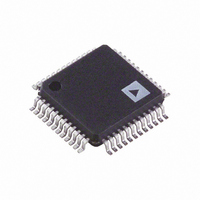ADM1062ASUZ Analog Devices Inc, ADM1062ASUZ Datasheet - Page 19

ADM1062ASUZ
Manufacturer Part Number
ADM1062ASUZ
Description
IC SUPERVISOR/SEQUENCER 48-TQFP
Manufacturer
Analog Devices Inc
Type
Sequencerr
Datasheet
1.EVAL-ADM1062LFEB.pdf
(36 pages)
Specifications of ADM1062ASUZ
Number Of Voltages Monitored
10
Output
Programmable
Voltage - Threshold
Adjustable/Selectable
Operating Temperature
-40°C ~ 85°C
Mounting Type
Surface Mount
Package / Case
48-TQFP, 48-VQFP
For Use With
EVAL-ADM1062TQEBZ - BOARD EVALUATION FOR ADM1062TQEVAL-ADM1062LFEBZ - BOARD EVALUATION FOR ADM1062LF
Lead Free Status / RoHS Status
Lead free / RoHS Compliant
Reset
-
Reset Timeout
-
Available stocks
Company
Part Number
Manufacturer
Quantity
Price
Company:
Part Number:
ADM1062ASUZ
Manufacturer:
Analog Devices Inc
Quantity:
10 000
Part Number:
ADM1062ASUZ
Manufacturer:
ADI/亚德诺
Quantity:
20 000
Company:
Part Number:
ADM1062ASUZ-REEL7
Manufacturer:
Analog Devices Inc
Quantity:
10 000
Monitoring Fault Detector
The monitoring fault detector block is used to detect a failure on an
input. The logical function implementing this is a wide OR gate
that can detect when an input deviates from its expected condition.
The clearest demonstration of the use of this block is in the
PWRGD state, where the monitor block indicates that a failure
on one or more of the VP1, VP2, or VP3 inputs has occurred.
No programmable delay is available in this block because the
triggering of a fault condition is likely to be caused by a supply
falling out of tolerance. In this situation, the device needs to
react as quickly as possible.
Some latency occurs when moving out of this state because it
takes a finite amount of time (~20 μs) for the state configuration
to download from the EEPROM into the SE. Figure 29 is a block
diagram of the monitoring fault detector.
VP1
VX5
LOGIC INPUT CHANGE
OR FAULT DETECTION
Figure 29. Monitoring Fault Detector Block Diagram
SUPPLY FAULT
DETECTION
WARNINGS
MONITORING FAULT
DETECTOR
1-BIT FAULT
DETECTOR
1-BIT FAULT
DETECTOR
1-BIT FAULT
DETECTOR
MASK
SENSE
MASK
SENSE
MASK
FAULT
FAULT
FAULT
Rev. B | Page 19 of 36
Timeout Detector
The timeout detector allows the user to trap a failure to ensure
proper progress through a power-up or power-down sequence.
In the sample application shown in Figure 28, the timeout next-
state transition is from the EN3V3 and EN2V5 states. For the
EN3V3 state, the signal 3V3ON is asserted on the PDO1 output
pin upon entry to this state to turn on a 3.3 V supply. This supply
rail is connected to the VP2 pin, and the sequence detector looks
for the VP2 pin to go above its undervoltage threshold, which is
set in the supply fault detector (SFD) attached to that pin.
The power-up sequence progresses when this change is detected.
If, however, the supply fails (perhaps due to a short circuit over-
loading this supply), the timeout block traps the problem. In this
example, if the 3.3 V supply fails within 10 ms, the SE moves to
the DIS3V3 state and turns off this supply by bringing PDO1
low. It also indicates that a fault has occurred by taking PDO3
high. Timeout delays of 100 μs to 400 ms can be programmed.
FAULT AND STATUS REPORTING
The ADM1062 has a fault latch for recording faults. Two registers,
FSTAT1 and FSTAT2, are set aside for this purpose. A single bit
is assigned to each input of the device, and a fault on that input
sets the relevant bit. The contents of the fault register can be
read out over the SMBus to determine which input(s) faulted.
The fault register can be enabled or disabled in each state. To
latch data from one state, ensure that the fault latch is disabled
in the following state. This ensures that only real faults are
captured and not, for example, undervoltage conditions that
may be present during a power-up or power-down sequence.
The ADM1062 also has a number of status registers. These include
more detailed information, such as whether an undervoltage or
overvoltage fault is present on a particular input. The status regis-
ters also include information on ADC limit faults. Note that the
data in the status registers is not latched in any way and, therefore,
is subject to change at any time.
See the AN-698 Application Note at
details about the ADM1062 registers.
www.analog.com
ADM1062
for full














